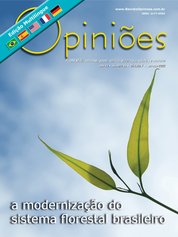Alex Passos dos Santos
Diretor da Maxitree Florestal
OpCP69
Um olhar para a produção e a qualidade das mudas
Recordo-me do meu ingresso como profissional no setor florestal, lá pelos idos de 2001. À época, ainda com meu mestrado em andamento, no qual me dedicava à avaliação silvicultural de clones de Eucalyptus spp. por macro e micropropagação, imaginava as diferentes possiblidades de aplicação da tecnologia de propagação vegetativa no setor florestal, incluindo mudanças no processo de produção de mudas.
A empresa na qual eu tive a oportunidade de começar a colocar em prática todos os ensinamentos adquiridos na universidade passava por uma modernização de seu viveiro de produção de mudas florestais, adotando o uso das modernas barras de irrigação, trazidas do setor de plantas ornamentais, dentre outras novidades, fonte constante de inovação e tecnologia que, com empenho dos profissionais do setor, transformavam-se nas “adaptações” à produção de mudas.
De lá para cá, pude presenciar inúmeras tentativas, em diferentes empresas e viveiros comerciais de produção de mudas, de se transformar o conhecimento tácito dos viveiristas em procedimentos, com a automação do processo sempre que possível. Cheguei a participar de um projeto multidisciplinar que visava ao manejo da irrigação em pleno sol por meio da instalação de sensores nos tubetes, que emitiam sinais sonoros quando o teor de umidade do substrato apresentava-se abaixo do esperado, para que o responsável pela irrigação pudesse acioná-la. Esse projeto não obteve o sucesso esperado, sendo a operação mantida pela avaliação visual e pelo conhecimento do responsável pelo processo.
O que se nota ao longo de todos esses anos foram, em sua maioria, tentativas frustradas de se modernizar e automatizar os viveiros de produção de mudas. Deparei-me, em diferentes viveiros, com centrais computadorizadas de controle dos minijardins clonais, casas de vegetação e áreas de pleno sol, que, mal haviam sido instaladas, tornaram-se obsoletas, estando ainda nas mãos do bom e velho viveirista as rédeas da produção de mudas, impactando diretamente a sua qualidade, sendo praticamente impossível a manutenção de um padrão.
Um dos poucos cases de modernização de um viveiro de produção de mudas nessa caminhada foi apresentado na edição nº 62 da Revista Opiniões, com o artigo intitulado a “Automação de Viveiros Florestais - A Era dos Dados a Favor da Silvicultura”, no qual o autor refere-se ao projeto do novo viveiro, recém-instalado na cidade de Três Lagoas (MS), como “Fábrica de Mudas”, que, como descrito por ele, teve início em 2009, com as primeiras prospecções e ideia de desenvolvimento, e teve seu startup operacional em março de 2017.
Um ano antes da startup desse viveiro, aconteceu uma das reuniões do recém-criado Programa Cooperativo sobre Mecanização e Automação Florestal (PCMAF), pertencente ao Instituto de Pesquisas e Estudos Florestais (IPEF), no qual foi decidido, pelas empresas participantes, que o PCMAF focaria na mecanização dos processos silviculturais.
Com a criação do programa cooperativo e as discussões sobre o tema, o número de fabricantes que iniciaram e deram continuidade aos investimentos em plantadoras só aumentou. Mas o que a produção de mudas pelos viveiros florestais tem a ver com a modernização no plantio? A resposta remete diretamente à qualidade de mudas e à sua influência na operação do plantio mecanizado.
E, para o tema “produção de mudas”, como podemos definir a “qualidade”, num cenário em que cada empresa possui seu viveiro de produção de mudas, em boa parte obsoleto, utilizando basicamente a mesma estrutura de 20 anos atrás, ou quem sabe até mais antigo? Em alguns casos, possui diferentes viveiros ou adquire muda do mercado e a envia para o plantio. Acrescente a isso o fato de que cada lote de mudas produzidas apresenta pelo menos três diferentes padrões de qualidade.
Diante desse cenário, como atender às demandas dos equipamentos, levando-se em consideração que cada plantadora desenvolvida ou em desenvolvimento tem sua peculiaridade e, para cada uma delas, características específicas das mudas são necessárias?
Imprescindível ressaltar que um ponto em comum entre as plantadoras com as quais já tive a oportunidade de ter algum tipo de contato é que esses equipamentos realizam o plantio das mudas por gravidade. Então, quando falamos dos requisitos de qualidade da muda para o plantio mecanizado, não podemos deixar de considerar a altura total da muda (substrato + parte aérea), o diâmetro do coleto, a tortuosidade do caule, o número de ramificações e de pares de folhas, a estruturação do substrato e o peso da muda. Via de regra, essas são características que, separadamente ou em conjunto, podem ser responsáveis pelo entupimento da plantadora, não atingimento da profundidade ideal e falhas de plantio, dentre outros problemas operacionais, quando não estão de acordo com o padrão definido como o da “muda ideal”.
Um grande fórum de discussão multidisciplinar precisa ser formado, no intuito de se pensar em conjunto sobre a modernização dos viveiros florestais, assunto que, volta e meia, retorna à mesa de debates. Em se pensando na operacionalização das plantadoras, faz-se necessário estabelecer os requisitos de qualidade das mudas, definir quais parâmetros realmente impactam o momento do plantio e de que forma conseguir que os viveiros atendam a essas demandas com qualidade. Fica claro o quão complexa é essa cadeia e a caminhada que o setor florestal ainda tem pela frente para que a modernização dos plantios florestais aconteça de forma efetiva.
Minha intenção, ao escrever algumas considerações para este artigo, é chamar a todos para uma reflexão sobre o tema e gostaria de finalizar citando o filósofo Mario Sérgio Cortella, que diz: “jamais seja incapaz de renovar seu próprio conhecimento”.




